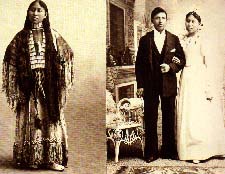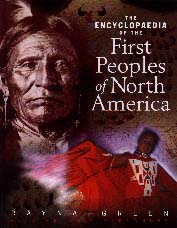|
________________
CM . . . .
Volume VII Number 3 . . . . October 6, 2000
excerpt: This book is an introduction to Native North American history and culture. It does not deal with the ancient people of North America or with the indigenous people of South America, but with the peoples inhabiting what became Canada and the United States from about 1,000 AD. In this book, we can give descriptions of only a very few of the over 300 tribal peoples of North America as well as fragments of their histories, religions, art, languages, an individual lives, but it does offer some introduction to the peoples, issues and ideas (past and present) that make up Native North American history and culture.  This introduction to Indian history comes as much through pictures and objects as through the
words of native people. It represents a simple map of the history - a visual history - of Native
North America. The objects, paintings and photographs show much that is painful as well as
beautiful; they mean to make a reader want to go in order to understand how much more there is
to know in that history.
This "Introduction" sets out the scope of The Encyclopaedia of the First Peoples of North
America; within these parameters, it does an admirable job. As the spelling of "encyclopaedia"
suggests, the book was originally published in Britain by the British Museum Press whose North
American collections are the source of the book's many photographs. However, the authors are
both North American Natives: Rayna Green is Director of the American Indian Program at the
Smithsonian Institute, while Melanie Fernandez is Community Arts Officer and Acting First
Nations Officer at the Ontario Arts Council. Together, they have created something rare: a
reference work which gives quite balanced treatment of both Canadian and American Indian
history and culture, and, in doing so, they heighten awareness of its trans-national nature.
This introduction to Indian history comes as much through pictures and objects as through the
words of native people. It represents a simple map of the history - a visual history - of Native
North America. The objects, paintings and photographs show much that is painful as well as
beautiful; they mean to make a reader want to go in order to understand how much more there is
to know in that history.
This "Introduction" sets out the scope of The Encyclopaedia of the First Peoples of North
America; within these parameters, it does an admirable job. As the spelling of "encyclopaedia"
suggests, the book was originally published in Britain by the British Museum Press whose North
American collections are the source of the book's many photographs. However, the authors are
both North American Natives: Rayna Green is Director of the American Indian Program at the
Smithsonian Institute, while Melanie Fernandez is Community Arts Officer and Acting First
Nations Officer at the Ontario Arts Council. Together, they have created something rare: a
reference work which gives quite balanced treatment of both Canadian and American Indian
history and culture, and, in doing so, they heighten awareness of its trans-national nature.
The book is "reader-friendly" and reinforces information literacy skills. It begins with a user's guide, clarifying how to find variant forms of words in the different languages, suggesting that readers follow up entries for words in bold type, and reminding students to check the general and individual indexes to find items without a main entry. Line maps indicate major settlement and cultural areas, and comprehensive source lists and picture credits provide readers with information which will lead "further than the pages of this book." Using the visually rich style popularized by Dorling-Kindersley's "Eyewitness" series, the photographs depict the artistry in everyday objects, the social and political dimensions of contemporary Native art, and how historical record is kept through pictures. But, the book also deals with difficult and controversial subjects: alcohol and alcohol abuse, gambling, and stereotyping are three that are given very fair treatment. Information not commonly-known is presented: I learned the etymology of the term "Indian", and, for the first time, had a clear understanding of how long-distant events, like the 1763 Royal Proclamation, which established Canada as a British colony, contains clauses which continue to be the basis for current land claims cases. Finally, colourized sidebars provide quotations, past and current, which comment on a variety of the main entries. Although the visuals make this book accessible to middle years students, older students with more knowledge of history are better able to see some of the connections amongst events. Because the book does lend itself both to browsing and reference use, teacher-librarians and/or teachers should read through the entire work in order to get a sense of its coverage and to see its limitations. Comprehensive and obviously well-researched, the book, nevertheless, listed the entry for Indian and Northern Affairs Canada under its former name of Department of Indian Affairs, Canada. However, these are small flaws in an otherwise very useful one-volume reference resource. Highly recommended for middle and secondary school libraries. Highly recommended. Joanne Peters is the teacher-librarian at Kelvin High School in Winnipeg, MB.
To comment on this title or this review, send mail to cm@umanitoba.ca.
Copyright © the Manitoba Library Association.
Reproduction for personal use is permitted only if this copyright notice
is maintained. Any other reproduction is prohibited without
permission.
Published by
TABLE OF CONTENTS FOR THIS ISSUE - October 6, 2000.
AUTHORS |
TITLES |
MEDIA REVIEWS |
PROFILES |
BACK ISSUES |
SEARCH |
ORDER |
CMARCHIVE |
HOME
|
